|
|
|
|
|
| Compañia Nacional De Danza 2 (National Dance Company of Spain): A troupe of fourteen dancers that serves as the muse for one of the world's most celebrated contemporary ballet choreographers, its artistic director Nacho Duato. View videoclip... |
Dervish: Straight from Ireland, Dervish's concerts with vocalist Cathy Jordan are a myriad of tones and moods ranging from high energy tunes to beautifully played airs, and from charming lyrics of life and love to inspiring melodies that will lift you from your seat. View videoclip... |
|
|
| Hungarian State Folk Ensemble: an ensemble of thirty dancers donned in authentic Hungarian dress will be joined by the world-famous Gipsy and Folk Orchestras to perform swirling, physically demanding folk dances rooted in the region's rich history and customs. with vocalist Cathy Jordan are a myriad of tones and moods ranging from high energy tunes to beautifully played airs View videoclip... |
Sydney Dance Company: Australia's foremost contemporary dance company returns with director Graeme Murphy's exhilarating Grand, a tribute to piano music, ranging from Bach to honky-tonk to Gershwin classics. View videoclip... |
| |
|
| Naxos-artist Markus Pawlik will delight the audience with a chromatic (greek for "colorful") program juxtaposing Bach's Chromatic Fantasy & Fugue and works by Reger, Liszt, and Busoni inspired by Bach. |
Named Top Classical Artists of the Year in 2005, Anonymous 4 comes to Penn for one night only. Renowned for it's tonal unity and technical virtuosity, this a cappella ensemble performs Long Time Traveling, a panorama of early Anglo-American music. |
|
|
|
Engraving Pyramid Tomb of Caius Cestius {From the Le Vedute di Roma (The Views of Rome), 1748-78} from the exhibit, Piranesi: The Grandeur of Ancient Rome. Sixty works by Giovanni Battista Piranesi, one of the major artists of 18th century Italian etching, are featured in this exhibition. Born in Venice and educated to be an architect, Piranesi spent most of his life in Rome, becoming an authority on Roman archaeology. Architectural remains of ancient Rome were a major source of inspiration to Piranesi, whose goal— was realized in numerous, often large-scale etchings of famous ancient sites. A superb technician, Piranesi combined a mastery of draftsmanship and perspective, a strong knowledge and love of Roman antiquities, a sense of drama and an epic imagination in his etchings. This traveling exhibition, coordinated by Blair-Murrah, includes engravings of Hadrian’s Villa in Tivoli, the ancient Roman Forum and the Pyramid Tomb of Caius Cestius, as well as many tombs, ancient amphitheaters, bridges, fountains and temples. Through June 16. |
Tapirapé: A wax figurine, Topu, representing the messenger of Kanawana, a supernatural spirit. Photo © Houston Museum of Natural Science from the exhibit, Vanishing Worlds: Art and Ritual of Amazonia. Prior to European contact beginning in the 1500s, between 3 and 5 million people thrived in the Amazon river basin region of South America, an ecologically diverse land mass of 2.5 million square miles. Today, fewer than 100,000 Amazonian native people survive, and the vast majority of people who once occupied the Amazon have disappeared forever. This exhibition features over 150 ritual objects from the Ka'apor, Karaja, Tapirape, Ticuna, Shipibo-Conibo, and Shuar, several Kayapo peoples, and Xingu River region peoples. Colorful headdresses, masks, body ornaments, and full body costumes, as well as domestic and utilitarian pieces like basketry, weapons, pottery and textiles, are showcased. Second floor Dietrich Gallery. Through June 30. |
International House Exhibits
|
|
|
 |
InLiquid.com will present a series of video works in the Gallery at International House. The project will showcase new and selected works by artists from InLiquid's Film and Video category and will be viewable daily from 8am to 8pm. New artists will be presented on a bi-monthly basis. Image by Anita Allyn. Through March 30. |
Multiple Eye: Ted Knighton’s Moving Images, An Exhibition of Art and Film. This exhibit includes paintings, drawings and a monitor playing two short films, Six Insects and Testing, running together in a loop, with a sculptural moving image project as the centerpiece. The central installation, Eye-Pod, is a sculptural “living geode” containing a non-narrative motion art piece comprised of sequential images, each hand-drawn like an animation cell. Through March 9. |
Love, Loss and Longing: The Impact of US Travel Policies on Cuban-American Families: Photo exhibit which shows the cruel human impact of the Bush Administration’s rules impeding contact between Cuban-Americans and their loved ones in Cuba. The photos represent 20 Cuban-Americans, from different walks of life, who can no longer visit their families in the island. Through April 9. |
Panoramas and Other Circular Stories
Esther Klein Gallery
Through March 31 |
 |
 |
| Roderick Coover is a multimedia artist and scholar whose work challenges the traditional borders of documentary form through experiments in motion, montage and multi-linearity. His solo exhibition, Circular Stories and Panoramas, includes six video works which have been created using layered photographs, audio and manipulated video recordings. These works are interconnected by common motifs of travel and time and evoke ways that technological imagery permeates the imagination and call attention to the place of desire in sensory experience and in language. |
Photographic Essay by Ed Dougert
Burrison Gallery
Through March 23 |
 |
| Image from the exhibit, The Black Land: Remnants of the Once Great Anthracite Coal Industry, A Photographic Essay by Ed Dougert. |
|
 |
Viktor Sykora, Charles University Institute of Pathophysiology/First Faculty of Medicine Prague, Czech Republic. Seed of a Clematis vitalba shrub (also known as Traveller’s Joy and Old Man’s Beard) (2x). 7th Place.
|
Charles Krebs Photography Issaquah, Washington: Wing scales of a Urania ripheus (Sunset Moth) (6.25x). 9th Place.
|
Art and Society: The Work of Fred Forest
Slought Foundation
Through March 23
|
|
Fred Forest, "La photo du téléspectateur," 1976; "Homage to Mondrian," Installation Plan, 1989; Detail from "La Bible Èlectronique," Center for Art and Technology, Reims, 1991; "Homage to Yves Klein," Museo del Sannio, Benevento, 1984
|
The Art of Reinvention: Travel — Exile — Recuperation
Rosenwald Gallery, Van Pelt-Dietrich Library
Through April 13
|
|
Presented in collaboration with the Penn Humanities Forum, this exhibition explores the tales of two artists whose political exile occurred fifty years apart. The Prague-born writer Franz Werfel became expatriated with the annexation of Austria by Germany in 1938. He and his wife, Alma Mahler, eventually settled in California and remained at the center of a vibrant émigré community of European artists, musicians, and writers. The exile of conceptual artist Kinga Araya from communist Poland in 1988 informs her work, which includes performance art, photography, sculpture, video, drawing, and writing. Their stories are juxtaposed through the display of artifacts and creative pieces that interrogate notions of identity and homeland.
|
Dissolution of Prepublic Image
Annenberg Center
Through April
|
|
Kanishka Raja's painting Dissolution of the Prepublic (Version 2) builds an improbable architectonic world by suturing together domestic interiors with stark airport terminals, urban vistas and runways in environments redolent of memory and mobility. Someone, though we cannot say for certain who, is simultaneously at home and in transit. Raja's psycho-geographic spaces set up a narrative tension but are devoid of specific subjects. By leaving the viewer to identify with the space of the painting one can project any number of imaginative narratives into it.
|
Equus Unbound: Fairman Rogers and the Age of the Horse
Kamin Gallery, 1st floor, Van Pelt-Dietrich Library
March 1 through June 15
|
Amarna, Ancient Egypt's Place in the Sun
Penn Museum
Through October
|
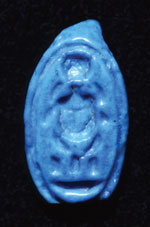 |
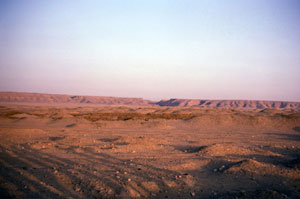 |
|
Ring bezel, Amarna, Dynasty 18, reign of Akhenaten (1353-1336 BCE), faience. Ring bezel decorated with the cartouche of Tutankhamun. Photo courtesy of Penn Museum.
|
The city of Amarna was bordered on its eastern side by cliffs of uniform height. Almost at midpoint of the city, the cliffs are interrupted by a gap (the Wadi Abu Hasan el Bahri). Viewed from afar, this break in the cliffs creates a large natural silhouette of the hieroglyph for "horizon" (akhet). Akhenaten may have chosen this site for his new capital city dedicated to his god, the disk of the sun, the Aten, because this natural rock formation created the "Horizon of the Aten" or, as it was known by its ancient Egyptian name, Akhet-aten. This view is taken from the south. Photo by David Silverman.
|
Statue of an Amarna Princess, probably from Amarna, Dynasty 18, reign of Akhenaten (1353-1336 BCE), limestone and pigment. Amarna art placed considerable emphasis on the six daughters of Akhenaten and Nefertiti: Meritaten, Meketaten, Ankhesenpaaten, Nefernefruaten Tasherit, Nefernefrure and Setepenre. The identity of this princess is not known. Photo courtesy of Penn Museum.
|
ICA Exhibits
Through March 25 |
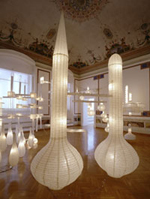 |
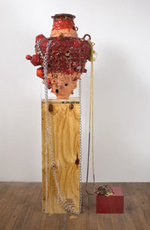 |
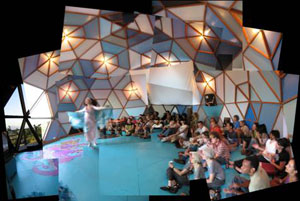 |
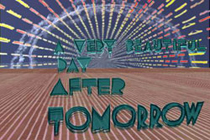 |
Carlos Garaicoa; Garaicoa has been working since the early 1990s using a multidisciplinary approach that includes architecture and urbanism, narrative, history, and politics. His works are charged with provocative commentary on issues such as architecture’s ability to alter the course of history, the failure of modernism as a catalyst for social change, and the frustration and decay of 20th-century utopias.
|
Nicole Cherubini;
hand-built from flat little clumps, use-free (they are full of holes), and over-scaled vessels, these G-Pots as they are called, are glazed repeatedly to create a seductive richness of hue. Built in layers, from the bottom-up, then glazed with different colors, the sculptures are then festooned with all manner of baroque appliqué or “bling”: making them willfully exotic in their array of materials and are relentlessly inventive. |
Locally Localized Gravity features the local scene, expanded exponentially. In cities like Philadelphia, artists have long operated as organizers, often collaborating with other artists to produce events, lectures, performances, concerts. While Philadelphia is the focus, Locally Localized Gravity includes artists from other cities who work in a similar spirit, including Los Angeles, Minneapolis, Portland, Oregon, and New York. The exhibition, which will include over 100 artists, musicians, designers, lecturers, performers, and creators, will be one non-stop event and on view in ICA's first floor galleries and terrace. Photo: Fritz Haeg. |
Luca Buvoli, composite of two video stills from "A Very Beautiful Day After Tomorrow (UN Bellissimo Dopodomani)," 2006. DVD, color, sound. This title names both the project and the artist's new video that makes its premiere as part of the multi-media installation. The words are also spoken by Marinetti's daughter Vittoria, who Buvoli interviewed as part of the video which presents central themes of Buvoli's recent work: velocity and flight. Photo: Luca Buvoli. |
Arthur Ross Gallery
Through May 6
|
|
Dramatic Impressions: Japanese Theater Prints from the Gilbert Luber Collection. Exhibition of works produced between 1916-1929 of Shunsen (1886-1960), a brilliant designer of woodblock. By focusing on representations of theater and actors, early modern printmakers developed a vocabulary of visual forms recreating the effects of staging, pose, make-up, and costume. |
 |
Butabu: Adobe Architecture of West Africa,
Photographs by James Morris
Penn Museum
Through March 3, 2007 |
|
|
For centuries, complex adobe structures, many of them quite massive, have been built in the Sahal region of western Africa—Mali, Niger, Nigeria, Togo, Benin, Ghana, and Burkina Faso. Made of earth mixed with water, these ephemeral buildings display a remarkable diversity of form, human ingenuity and originality.
British photographer James Morris offers a stunning visual survey of these structures, from monumental mosques to family homes, in Butabu: Adobe Architecture of West Africa, Photographs by James Morris. |
Great Gardens of the Philadelphia Region
Morris Arboretum
Through May 13 |
 |
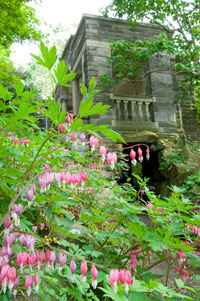 |
| Great Gardens of the Philadelphia Region: An inspired photographic tour of the Delaware Valley's rich and diverse horticultural legacy as seen through the lens of renowned photographer Rob Cardillo. From the majestic estates of Delaware, to the vital community gardens of center city, this exhibit reveals why Philadelphia and its surrounding towns, suburbs and countryside are considered the horticultural epicenter of the United States. Above left: Balustrade surrounding the iconic Rose Garden at the Morris Arboretum; Above right: View to the Mercury Loggia at the Morris Arboretum. Bleeding heart (Dicentra spectabilis) in foreground |
meta Metasequoia
Morris Arboretum
Ongoing |
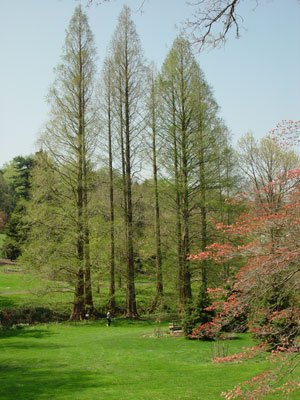 |
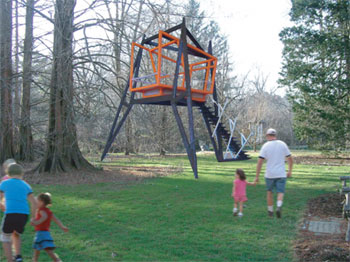 |
| Nestled within the dawn redwood grove, meta Metasequoia will provide a fresh perspective of these wonderful trees. The exhibit will elevate visitors up into the tree canopy of the dawn redwoods by means of an artistic structure with stairs leading to the "basket," an open-air room whose floor is 12 feet above grade. Climbing up into the structure, nicknamed the "Grasshopper," visitors will be able to revist the childhood feeling of being in a tree house, enjoy the views and relax in unusual intimacy with these majestic trees. |
Coming to the Small Screen: Ormandy & Television
Eugene Ormandy Gallery, Van Pelt-Dietrich Library
Ongoing |
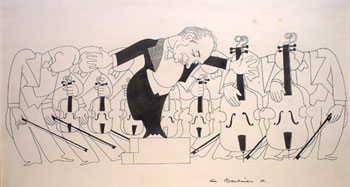 |
| Drawing by Alfred Bendiner, ca. 1952.
Eugene Ormandy dedicated his life to music, from the age of three, when he first picked up a violin, to shortly after his 84th birthday, when he conducted his last concert with the Philadelphia Orchestra. It is with this orchestra that Ormandy's name will forever be associated, by virtue of his serving as its Music Director for 42 years. Image courtesy of the University of Pennsylvania Architectural Archives. |
A Wonderful Life: A Daughter's Tribute to a Family of Educators
Lobby, GSE
Ongoing |
|
Pennsylvania Daughter by Joan Myerson.
Digital "painting" of the artist's mother as Penn student.
|
|
Almanac -
February 27, 2007, Volume 53, No. 24
|
|
|